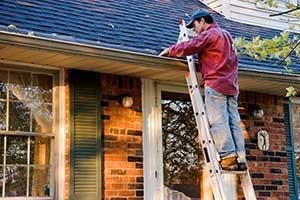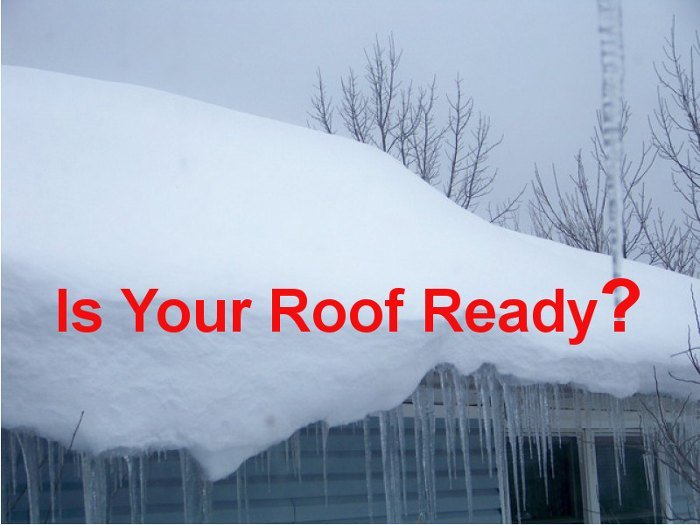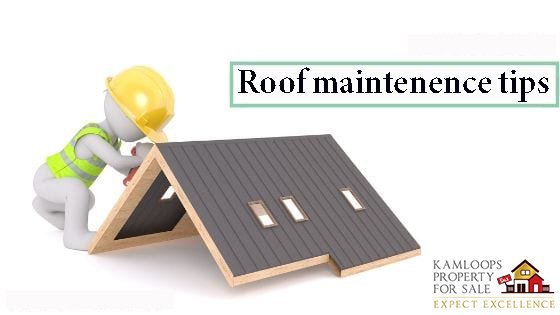 The roof protects you and your home from all kinds of weather, bugs, animals and falling debris. Yet we rarely think about the roof until it’s too late—and then it can be a big investment.
The roof protects you and your home from all kinds of weather, bugs, animals and falling debris. Yet we rarely think about the roof until it’s too late—and then it can be a big investment.
Unfortunately, when prepping your house for the icy grips of winter, it isn’t all fun, games and decorations. You’re going to want to ensure that your home is adequately prepared to endure the harsh reality of an unpredictable winter by weatherproofing its infrastructure and employing general fall roof maintenance and upkeep tasks.
Before that very first snowflake hits the ground, there is plenty to be done when it comes to home maintenance, and no – the first thing to check off the box isn’t hanging up your Christmas lights. So, what’s first on the list? Well, as colder weather starts to creep in, fall roof maintenance should be pretty high on your to-do list.
Roofing Protects Your Home
Your roof is your home’s first defense against hailstorms, heavy winds and leaks. So you might want to consider whether or not it needs to be reinforced, looked at by a roofing professional, or requires reshingling to bolster its defenses against the possibility of leakage. Although the task may seem tedious, you’ll want to think about these things sooner than later. It may just pay off in the future. On the other hand, if you pass roof maintenance off as unimportant the first sign that anything has gone awry might be some pretty expensive water damage thanks to water leakage from melted snow.
It’s likely that you might want to push off all that grunt-work into the winter. Of course, while that is possible, there are a number of obstacles you might run into by taking that route. First, winter is cold. There’s no question. When the temperature plummets, you could be looking at a really tough job for your roofers. A quick job is usually a lousy job and that certainly isn’t the kind of work you’re looking for when it comes to your roof. You’ll want to have your roofers get to work long before the snow sets in to ensure that the job that needs doing is done the best it possibly can be.
Also, certain materials may become brittle when installing in the winter, making them a lot more prone to cracking or even breaking while they are being implemented. These cracks allow for any small amount of water to seep inside and freeze in the cold, causing the cracks to expand. The larger cracks will allow for more water to permeate the roof, eventually seeping into space beneath. Ultimately, this can be a lot for you to deal with later down the road.
So if you need to reshingle your roof, your best bet is to get everything done before the winter months come along. Once the tedious stuff is out of the way, you can get down to what you’re most excited for: decorating for the holidays and throwing up your decorations on the mantel. You can rest easy knowing that your roof is sound and that everything that needed updating is done before the first snowfall.
The Stages of a Roof Lifespan
Your home’s roof is a significant investment that you can expect to last for many years. Roofing materials are carefully manufactured to withstand most environmental stresses. However, extreme weather conditions and the level of maintenance you provide for your roof over time can have a significant effect on its longevity. Here is a general schedule of how you can expect your roof to age with the passage of years.
Initial Years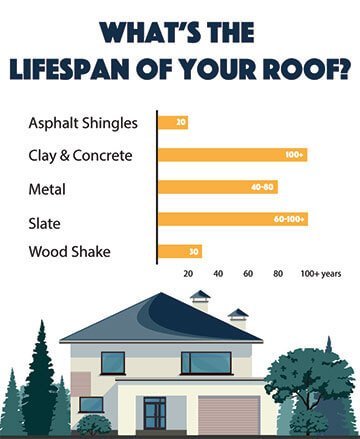
Your home’s roof will start out looking clean, with good color and no evidence of wear. Under ideal conditions, you can expect your roof to continue to retain its brand new appearance and function throughout the initial years. However, regional climate conditions, such as extreme snowfall, heavy rains and frequent hail can cause your roofing materials to become damaged sooner than expected. Pitting, softening of asphalt or cracking can occur. If you live in an area with extreme weather conditions, make a point to do regular inspections of your roofing material to ensure that early signs of wear or deterioration are managed properly.
Five To Seven Years
Over time, roof damage can accelerate due to weather conditions, overhanging trees, pollutants in the air and other factors. During this stage, you will begin to clearly see the factors that impact your roof’s longevity. The roof’s ability to shed snow, the likelihood of damage from tree sap and overhanging branches, as well as local environmental contaminants will begin to effect the appearance of your roofing materials. You may have established a schedule for cleaning your gutters and examining the condition of the roof. You may have already noted areas of potential damage that will need to be monitored to avoid future problems. These signs may alert you to the need for pruning tree branches to prevent damage.
Eight to Twelve Years
During the time period from eight to twelve years, homeowners need to ensure that roof materials retain their ability to protect internal construction materials. Asphalt shingles may show some curling, cracking or separation during this period. Replacing damaged shingles and ensuring that underlying roofing materials are intact is an essential way to extend the life of your asphalt roof. Clay and concrete roofs should be carefully examined for cracks or loosening of tiles. Mold can grow on the surface of tiles and intrude into margins, causing looseness and damage to underlying material. A reputable roofing contractor can remove this mold safely, without doing damage to the existing tiles. Metal roofs should be regularly cleaned of leaves and other vegetative debris. Maturing trees can cause damage on any type of roof and should be removed, as needed, as the years pass.
Twelve To Twenty Years
As the asphalt tile roof moves toward the end of its lifespan, the homeowner should increase the amount inspections and repairs to ensure that the roof lasts as long as possible. If you have done ongoing maintenance on your asphalt roof, the damage may be minimal at this point, and you will be able to plan its replacement more conveniently. Clay or concrete roof materials may require minor repairs or tile replacement. Metal roofing may also need some minor tightening of fasteners to ensure effective function. All types of roofing materials can be damaged by foot traffic. Keep walking on the roof down to a minimum to preserve the roof lifespan.
Twenty+ Years
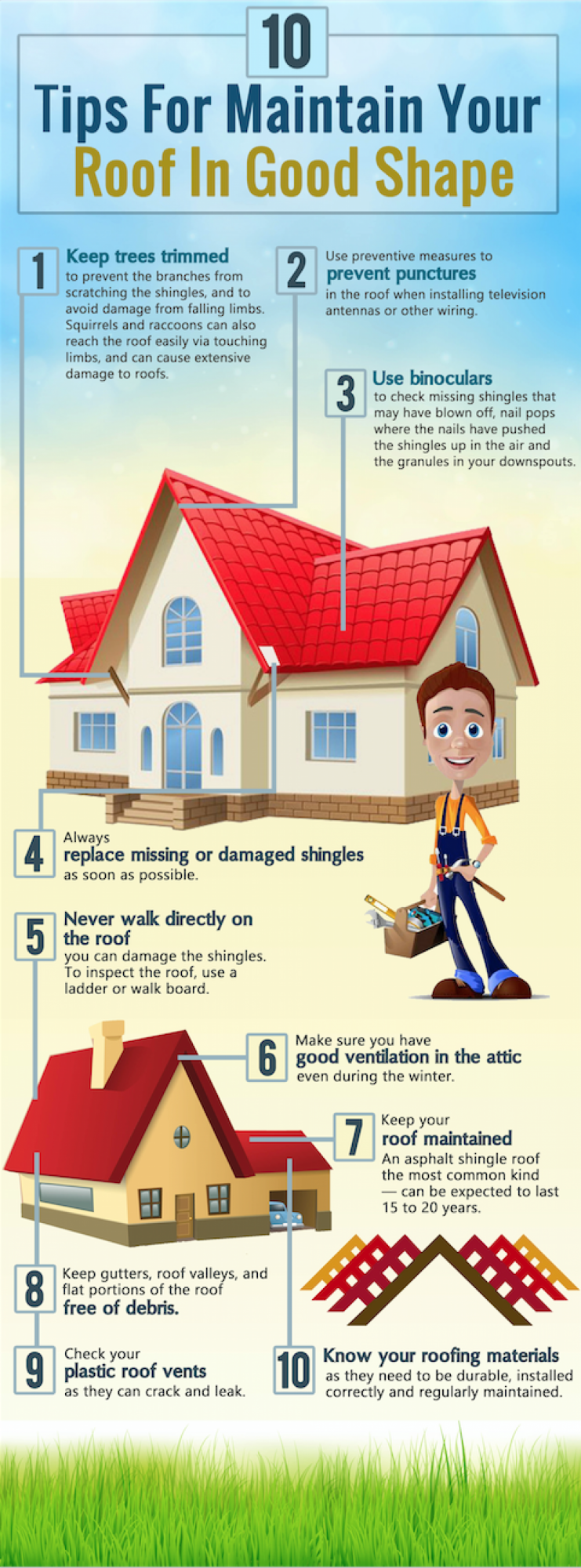 The expected roof lifespan for asphalt is about 20 years. If you have reached this deadline, it’s a good idea to begin talking to contractors about roof replacement. Clay and concrete roofs have a longer lifespan, at about 60 years. However, inspections may reveal areas of damage that require attention to ensure that the roof continues to provide protection for your home’s interior and exterior. Metal roofs are said to last as long as 40 to 60 years, but after 20 years, even this material may require some repairs to correct minor separation and corrosion of fasteners to ensure that damage to materials under the metal does not occur.
The expected roof lifespan for asphalt is about 20 years. If you have reached this deadline, it’s a good idea to begin talking to contractors about roof replacement. Clay and concrete roofs have a longer lifespan, at about 60 years. However, inspections may reveal areas of damage that require attention to ensure that the roof continues to provide protection for your home’s interior and exterior. Metal roofs are said to last as long as 40 to 60 years, but after 20 years, even this material may require some repairs to correct minor separation and corrosion of fasteners to ensure that damage to materials under the metal does not occur.
Doing annual inspections of your roofing materials will help you to find small problems early, before they become larger, more expensive issues and will increase the roof lifespan. Make a habit of doing a visual inspection of your roof from street level on a periodic basis to detect minor wear.
Fall Roof Maintenance is Important…What to keep an eye out for!
No one wants their spring to start by discovering that their roof has become the host of a whole new ecosystem of fungi, mould and mildew. It might seem trivial to deal with, but the smallest buildup of moisture and a few leftover leaves can manifest into one humongous, globular mass that blocks your drains and clogs the natural flow of water. This build-up of debris can cause backed-up water which only supplements the live load on your roof’s deck. Standing water, as it is known, can actually cause a lot of damage to the properties of your roofing material and over time reduce its longevity and durability.
In winter, these pools of standing water can freeze over. When water freezes over it expands and can cause breaks and damages in your roof material. In the worst of scenarios, this can cause total roof collapse. So while that small accumulation of leaves, sticks and other debris may seem like nothing, take care of it before the snow falls. It’s better to be safe than sorry.
This goes along with checking your gutters and drainpipes before the winter months. An essential part of weatherproofing your roof and home is preventative maintenance. If you think you need to, you can hire a professional to help clean your roof and gutters. This can be extremely beneficial for later down the road when your gutters are clean of snow and debris and aren’t putting you at risk of standing water buildup which severely damages your property’s foundation and siding.
Another step to proper roof maintenance before winter that might seem inconsequential is trimming the dead or outstanding and overgrown branches around your home. You can hire a professional for this or you can do it yourself. The branches that are most important to address are the ones that have branches near your roof. Sometimes heavy snowfalls or extreme winds during ice storms can cause these branches to break and fall onto your roof, dealing damage to the physical integrity of your home. These repairs can be costly, so it’s best to nip the issue in the bud before it grows out of hand.
Of course, contacting a professional is another major way of ensuring that your roof is up to the task of enduring the brunt of a potentially harsh winter. An expert will have the tools necessary as well as the right safety equipment to ensure your roof is healthy and ready.
How to Inspect Your Roof
More than anything, you are going to want to inspect your roof first to ensure it’s up to the task of holding through the perilous winter months. Your best bet is to avoid climbing on your actual roof’s structure itself – which while dangerous in and of itself is definitely not something you’re going to want to do in the snowy weather, as ice and snow can cause your roof to be quite dangerous. Here are the DIY steps to roof inspection.
Do an overall sweep
Walk around the exterior of your home. In this sweep, you can inspect your roof from where you are on the ground to detect any signs of sagging, ageing, deterioration and damage. It is important at this stage to take note of any potential issues or spots which require closer inspection or a professional review.
Search for debris buildup
Once again, debris buildup is one of the major causes of blockage leading to water damage and expensive leaks. Check for areas where moss and algae seem to be gathering the most or accumulating piles of leaves.
Check for heat-damaged shingles
One major indication of heat damage to roofing material is curled or even buckled shingles. How does heat damage happen? Heat damage is a product of hot air coming from your home’s attic, which results in shingles curling away from your property. This can be a huge issue in the winter as it can result in poor ventilation and leave your roof exposed to weather damage.
Make notes of roof rot
When you are assessing your gutters and roof overhangs, make note of any signs of rot or open joins. These can be huge indicators of much larger issues which, during the wintertime, can bring on a whole host of problems for your roof and home.
Investigate granule loss
Granule loss can be an indicator that your shingles have begun to deteriorate over the years or were damaged by severe weather in the past. If you see this, your roof is no longer protecting your home as sufficiently as it could against damaging storms! Granule loss is essentially a lack of texture on shingles. If you notice this, it’s time to replace them.
Once you have completed your home inspection, you should review your findings. Did you notice any potential concerns or damages? If you see anything you deem out of the ordinary, considering hiring a professional roofer to do a more thorough inspection or help you out with repairs and replacements. It is important to fix any concerns you might notice in this stage before they become much larger issues later down the road.
Key Roof Maintenance Takeaways
Whether you are performing room maintenance in the fall before the first snowfall or doing so just after you’ve had a new installation, there are so many things to consider. What roof material is the best? Do I need to contact a roofing professional? Should I be worried about x or y? For your convenience, here are a few roof maintenance takeaways you should take into consideration:
Do a thorough roof inspection
By following the steps listed above, you can ensure that your roof inspection is sufficient and thorough. Ideally, you do this inspection right away after a new installation but it would also be beneficial for you to ensure that at least one inspection is done per year so as to guarantee that your roof is ready for the winter. To further guarantee that your roof is up to par, you may also want to do one in the spring as well. As a bonus, take a peek at your roof after extreme weather events as well to assess whether it has sustained any damage. If you need help or you are not sure what to look for, have maintenance staff or a roofing professional do a review for you.
Prevent debris from accumulating
Standing water, caused by the accumulation of leaves, branches and other debris, can be severely detrimental to the foundation of our roofs. When debris gathers and blocks our scuppers and drains, it can create ponds and cause unnecessary weight to buildup on our rooftops. The water has nowhere to go and so, come winter, it can only do one thing: freeze. When water freezes it expands, pushing apart our shingles and roofing material, causing cracks and breaking shingles. Ultimately this will cause your home to be more vulnerable to further damage, leakage and poor ventilation. Luckily, preventing debris buildup is incredibly easy to do! Ensure that you regularly assess the state of your rooftop debris, especially during autumn when falling leaves tend to be the biggest contributors to blockage.
Keep roofing records
Like journaling – but for roof maintenance. Your roofing file should include documents from its original installation (if you have them), including plans and specs, as well as the information from the contractor who did the job. Warranties, inspection reports, maintenance, contact information and anything you think might be useful are all helpful additions as well. If repairs need to be made or you need to install equipment onto your roof, this information can come in handy – especially for a roof that is under warranty. This also holds you accountable for how recently your roof was renovated or updat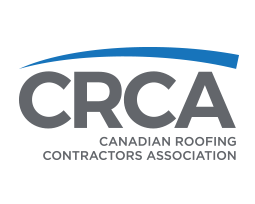 ed so you can check to see if you are due for a reshingling.
ed so you can check to see if you are due for a reshingling.
Work only with certified roofing professionals
This probably goes without saying, but ensure that if you do hire a professional to help maintain your roof or look after any damages or issues that you choose someone who is properly certified. Plenty of manufacturers will have a certified maintenance program. Your roof is one of the first defenses against the extremes of winter so you’re going to want to ensure that it is looked after by someone who knows exactly what they are doing! The Canadian Roofing Contractors Association
Roofing DIY Repairs
Trying to tackle roof repairs is often best left to professionals, but if you have some DIY skills, and do not mind tackling a roof project yourself, here are a few things should consider. Remember, safety first!
Roof Safety
Roofing repairs demand extra attention to safety measures to prevent falls. If you feel uncomfortable working on a ladder or your home is multiple stories, consider using a scissor lift, which can make working on your roof much simpler and safer. Ideally, all repairs should be done on a warm, dry day.
Never attempt roof repair under a blazing sun or during wet or icy conditions. Wear boots or shoes with non-slip soles to reduce the risk of slipping and falling. As with any task rife with peril, bring along a partner for assistance.
Replacing Shingles
Begin with the shingle in the second row above the one to be replaced. We’ll assume your roof is topped with the most common three-tab asphalt shingles.
- Slip a pry bar in the gap between the two undamaged shingle rows and gingerly lift the tabs 45 to 60 degrees to avoid cracking their brittle composure.
- Pry out the row of exposed nails that secure the above shingle row to the damaged one.
- Slide the bar under the next row down to remove the nails on the damaged shingle.
- Work loose the shingle from its adhesive attachment, and extract it from your roof.
- Clean the surfaces to remove any dirt or debris.
- Position the new shingle in its proper place, nail it to the roof and then re-nail the above shingle.
- The final step entails resealing the three shingles with a dab of shingle cement under each tab.
With basic DIY knowledge, most consumers can easily tackle the steps above. Incorporating fall roof maintenance into your annual home maintenance plan will not only save you money long-term, but will ensure your home is protected from bad weather.
Cleaning Gutters
Hire your trusty scissor lift once more, or utilize a good ladder, and begin purging the gutter of accumulated debris at the lower end drain outlet. A small garden spade works nicely for this task. Scoop out the slurry of dirty leaves and gunk, and toss them into a bucket for easy disposal. Next, utilize the water-blasting talents of your garden hose by equipping a high-pressure nozzle. Blast the gutter’s remains in the direction of the drain outlet until each stretch of gutter is flushed clean.
For further cleaning, use aluminum cleaner and steel wool to scrub down the encrusted insides. If the drainpipe isn’t releasing water, you may have a clog. Push a flexible plumber’s auger from either the top or bottom to remove the blockage. It really is that easy.
Final Roof Maintenance Tips
Fall roof maintenance may not be the first thing to cross your mind once you start packing up all your Halloween decorations. It might not even be the second, third or fourth. However, it pays to keep in mind that your roof is your first defense against the devastating effects of extreme cold. Keeping it properly maintained is an essential part of your overall home maintenance.
That maintenance includes regular assessments, cleaning, decluttering, and so on. You should always look to the help of a professional! So, put those Christmas decorations away for now and look after your fall roof maintenance before you start getting festive. You’ll thank yourself in the long run!
